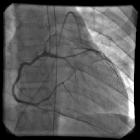transseptaler Verlauf Koronarterie



A transseptal, intraseptal or subpulmonic course refers to a coronary artery passing anteriorly and inferiorly to the aortic valve in a subpulmonic route through the interventricular septal myocardium and is mostly described as a ‘benign anomalous course’ without hemodynamic significance.
Epidemiology
Associations
Clinical conditions associated with a transseptal course of a coronary artery include :
- other congenital coronary artery anomalies
- ectopic origin of the left anterior descending artery
- ectopic origin of the left main coronary artery
- other forms of congenital heart disease
Clinical presentation
Similar to a prepulmonic or retroaortic course a transseptal course is apparently not of increased hemodynamic risk and might be found incidentally on invasive coronary angiography (ICA), cardiac CT or cardiac MRI. Other conceivable symptoms include angina or arrhythmia .
Radiographic features
A transseptal or intraseptal course is usually associated with an ectopic origin of either left anterior descending artery, left main coronary artery or right coronary artery. It can be depicted on coronary CTA or coronary MRA or invasive coronary angiography (ICA) as a major coronary artery coursing through the interventricular septum .
Features indicating a transeptal course versus an interarterial course include the following :
- artery surrounded by the myocardium of the interventricular septum
- downward course below the crista supraventricularis (hammock sign)
- no slitlike or oblong orifice
Radiology report
The radiology report should include a description of the following features:
- right coronary artery origin, course, segments
- left main coronary artery origin and variant anatomy
- left anterior descending artery with course branches and segments
- circumflex artery with course, branches and segments
- coronary artery disease and stenoses with location based on the AHA coronary artery segment model
- any associated congenital cardiovascular anomalies
Treatment and prognosis
A retroaortic course is considered benign and not of hemodynamic importance. Management will entirely depend on symptoms and on associated findings. However, it can complicate aortic valve surgery .
Differential diagnosis
A condition which can mimic the radiological appearance of a transseptal course is an interarterial course, the latter is associated with increased risk of sudden cardiac death .
See also
Siehe auch:

 Assoziationen und Differentialdiagnosen zu transseptaler Verlauf Koronarterie:
Assoziationen und Differentialdiagnosen zu transseptaler Verlauf Koronarterie:
